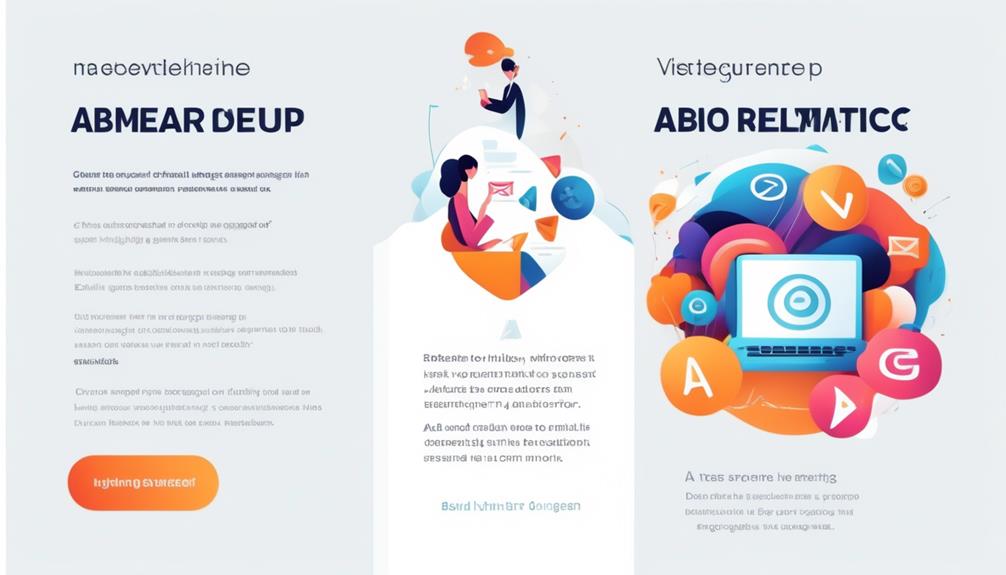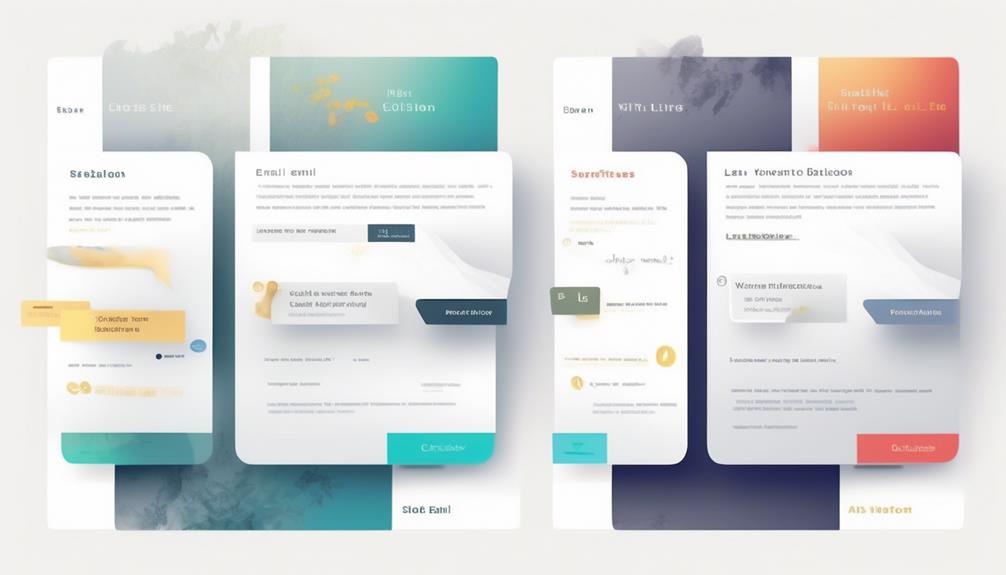It is crucial to conduct A/B testing in your email campaigns in order to improve the efficiency of your email marketing strategies.
But with so many variables to consider, it can be overwhelming to know where to start.
That's why we've compiled 7 key tips that can make a significant impact on the success of your A/B testing efforts.
From isolating test variables to defining your target audience, these strategies will help you unlock valuable insights and drive better results.
Key Takeaways
- Isolating variables in email A/B testing is crucial for gaining clear insights into the impact of specific variations.
- Incorporating a control version in email A/B testing establishes a baseline for comparison and accurately analyzes the effectiveness of any changes made.
- Simultaneous testing allows for concurrent comparison of multiple email versions, providing quicker insights and informed decision-making.
- Validating statistical significance is crucial when analyzing the results of an A/B test to ensure reliable decision-making based on robust data.
Isolate Test Variables
Isolating test variables in email A/B testing is crucial for accurately assessing the impact of individual elements on campaign performance. When conducting A/B testing, focusing on one variable at a time is imperative to gain clear insights into the effect of specific variations.
By isolating variables such as subject lines, the impact on open rates, and conversion rates becomes more evident. Analyzing the impact of each isolated variable provides valuable data for making informed decisions and refining email content effectively.
This approach allows for a thorough understanding of which elements contribute to the success or failure of an email campaign, leading to more strategic and impactful adjustments. It's essential to ensure statistical significance when testing, and isolating variables aids in achieving this by clearly identifying the impact of each change.
Use Control Versions

How can we effectively establish a baseline for comparison in email A/B testing?
When it comes to email A/B testing, using a control version is crucial for accurately measuring the impact of any alterations. Here's why incorporating control versions is essential:
- Unchanged Baseline: The control version serves as an unchanged baseline, allowing for a direct comparison with the variations being tested.
- Impact Measurement: By comparing the performance of the control version with the variations, we can accurately analyze the effectiveness of any changes made.
- Reference Point: The control version acts as a reference point for evaluating the success of the tested elements, such as subject lines, CTA buttons, or other marketing components.
- Accurate Results: Incorporating a control version ensures that the A/B testing results are reliable and accurate, providing valuable insights for email marketers to optimize open rates, conversion rates, and overall email effectiveness.
Simultaneous Testing
To maximize the efficiency and speed of email A/B testing, employing simultaneous testing allows for the concurrent comparison of multiple email versions, facilitating quicker insights and informed decision-making. This method is invaluable for evaluating a range of variables simultaneously, leading to more efficient testing and faster decision-making.
Simultaneous testing enables marketers to gather comparative data on different elements within the same timeframe, aiding in quicker optimization of email marketing strategies. It's particularly effective when multiple changes or elements need to be tested in an email campaign. By running simultaneous tests, marketers can efficiently optimize various aspects of their emails without extending the testing duration, ultimately leading to improved results in terms of open rates, click-through rates, and conversion rates.
This approach can be used to test different elements such as subject lines, email copy, and offers, providing valuable insights that can inform marketing decisions. Overall, simultaneous testing streamlines the A/B testing process, allowing for comprehensive testing of multiple variables in a shorter time frame.
Validate Statistical Significance

When analyzing the results of an A/B test, it's crucial to validate the statistical significance of the differences in performance between the email variants to ensure reliable decision-making based on meaningful results.
Here are the key steps to validate statistical significance:
- Use statistical tools: Employ statistical tools such as t-tests or chi-squared tests to determine if the differences in performance between your email variants are statistically significant.
- Ensure a large enough sample size: Validate statistical significance by ensuring that the sample size is large enough to draw meaningful conclusions. Small sample sizes may lead to unreliable results.
- Increase open rates: By confirming statistical significance, you can be confident that any observed increase in email opens isn't due to random chance, providing actionable insights for improving future email campaigns.
- Make informed decisions: Validating statistical significance ensures that the observed differences in performance between email variants are reliable and not merely coincidental, allowing you to make informed decisions based on robust data.
Continuous Testing
Let's talk about the importance of testing frequency, varied content, and monitoring results in continuous testing.
By testing frequently, we can gather valuable data to make informed decisions about our email content.
Varying the content allows us to understand what resonates best with our audience and continually improve our email performance.
Monitoring results ensures that we can adapt and optimize our email campaigns in real-time for better engagement and results.
Test Frequency
Engage in ongoing A/B testing to continuously optimize and refine various elements of our email campaigns. Continuous testing helps us make informed email marketing decisions and constantly improve our strategy.
Here's why test frequency is crucial:
- Varied Email Clients: Different email clients might test different rendering, making continuous testing essential for compatibility.
- Email Open Rates: Testing different subject lines and content can significantly impact email open rates.
- Personalization and Segmentation: Continuous testing helps optimize personalization and segmentation for enhanced engagement.
- Overall Campaign Performance: Regular A/B testing ensures that our email campaigns consistently perform at their best.
Varied Content
Continuous testing of varied content elements in email marketing is essential for optimizing performance and enhancing engagement with our audience. By using A/B testing, we can isolate and measure the impact of specific content elements such as subject lines, personalization, images, call to action, and timing on email performance. Testing across multiple email clients ensures consistent rendering and user experience. It's crucial to define our audience and segment them randomly for accurate testing, gathering valuable insights. Proper data management and monitoring results are essential for making informed decisions to continuously improve our email marketing strategy.
| Content Element | Metric | Best Version Might See Which % |
|---|---|---|
| Subject Lines | Open Rate | 25% |
| Personalization | Click-Through Rate | 18% |
| Call to Action | Conversion Rate | 15% |
Monitor Results
Continuously monitoring the results of our email A/B tests allows us to gather ongoing insights on the performance of different email variations. Here's why continuous testing is crucial:
- Identify trends and patterns in conversion rates and open rates.
- Analyze and compare data to understand the impact of subject line variations.
- Use insights to iterate and improve email campaign elements.
- Detect shifts in audience behavior and preferences.
Test Across Email Clients

When testing email campaigns across multiple email clients, it's crucial to ensure consistent rendering and optimized user experience. A/B testing across various email platforms and devices is essential for achieving this goal.
It's important to use A/B testing tools that allow you to preview and test emails across different email clients, considering factors such as formatting, images, and responsiveness. This approach ensures that your emails appear as intended and provide a seamless experience for all recipients, regardless of the email client they use.
Testing across email clients can also help maximize the effectiveness of your marketing efforts by optimizing conversion rates and open rates. It allows you to refine elements such as the subject line, testing ideas, transactional emails, and send time to better resonate with your target audience.
Define Target Audience

To optimize A/B testing decisions for email campaigns, a clear understanding of the target audience's characteristics and preferences is crucial. This knowledge allows for the creation of tailored email variations that resonate with the audience, ultimately leading to improved conversion rates.
Here are key steps to define your target audience for effective A/B testing:
- Demographics and Behaviors: Utilize customer data to understand the demographics, behaviors, and preferences of your audience, informing the creation of different versions of emails that are likely to resonate.
- Audience Segmentation: Segment your audience based on specific criteria such as age, location, or past engagement. This allows for targeted A/B tests, ensuring that each email version reaches the most relevant recipients.
- Addressing Unique Needs: Consider the unique needs and pain points of your target audience when creating email variations for testing. This personalized approach can significantly impact open rates and engagement.
- Continuous Refinement: Continuously refine and update your understanding of your target audience to ensure the relevance and effectiveness of your A/B testing efforts. This can be achieved through the use of email automation and ongoing analysis of customer data.
What Are Some Additional Tips for Successful Email A/B Testing?
When it comes to successful email testing tactics for success, consider testing one element at a time for accurate results. Also, ensure your sample size is large enough for statistically significant data. And don’t forget to analyze your results to inform future email campaigns.
Frequently Asked Questions
How to Do Ab Testing for Emails?
When it comes to A/B testing for emails, we focus on testing different subject lines, personalizing content, experimenting with images, timing email sends, and identifying effective CTAs.
These actions help us understand what resonates with our audience and drives engagement. By analyzing the data from these tests, we can make informed decisions to optimize our email campaigns for better results.
It's all about finding what works best for our subscribers.
How Do You Do an Effective Ab Test?
We conduct effective A/B tests by:
- Defining clear hypotheses
- Testing one variable at a time for accurate measurement
- Using a large enough sample size for statistical significance
After conducting the A/B test, we:
- Iterate and improve based on the insights gained from testing
- Implement the winning version
- Apply the learnings from the A/B test
This allows us to:
- Continuously optimize and enhance our strategies
- Ensure data-driven decision-making
- Maximize the impact of our testing efforts.
What Are the Key Metrics for a B Testing?
Key metrics for A/B testing include:
- Open rates
- Click-through rates
- Conversions
These metrics measure the effectiveness of different variations in engaging recipients and driving desired actions. Analyzing these metrics provides valuable insights into what resonates with the audience and what drives results.
On What Part of Parts of Your Email Can You Conduct a B Testing?
We can conduct A/B testing on various parts of our email to optimize engagement and conversion rates. This includes subject lines, personalization, images, call to action, and timing.
By testing variables like length, personalization impact, image types, CTA variations, and optimal send times, we can gather valuable insights to enhance the effectiveness of our email marketing campaigns.
These tests are essential for refining our strategies and maximizing results.
Conclusion
In conclusion, email A/B testing is a powerful tool for optimizing marketing strategies. By isolating variables, using control versions, and continuously testing, we can gain valuable insights into what resonates with our audience.
It's like fine-tuning a musical instrument to create the perfect harmony in our email campaigns. With continuous testing and data-driven decisions, we can achieve better results and drive greater success in our email marketing efforts.









